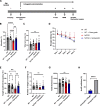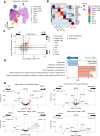Gossypetin ameliorates 5xFAD spatial learning and memory through enhanced phagocytosis against Aβ
- PMID: 36271414
- PMCID: PMC9585741
- DOI: 10.1186/s13195-022-01096-3
Gossypetin ameliorates 5xFAD spatial learning and memory through enhanced phagocytosis against Aβ
Abstract
Background: Microglia are the resident immune cells found in our brain. They have a critical role in brain maintenance. Microglia constantly scavenge various waste materials in the brain including damaged or apoptotic neurons and Aβ. Through phagocytosis of Aβ, microglia prevent the accumulation of Aβ plaque in the brain. However, in Alzheimer's disease (AD) patients, chronic exposure to Aβ makes microglia to become exhausted, which reduces their phagocytic activity against Aβ. Since microglia play an important role in Aβ clearance, enhancing microglial phagocytic activity against Aβ is a promising target for AD treatment. Therefore, there is a great need for therapeutic candidate that enhances microglial Aβ clearance while inhibiting microglia's pathogenic properties.
Methods: In vivo studies were conducted with 5xFAD AD model mice by treating gossypetin for 13 weeks through intragastric administration. Their spatial learning and memory were evaluated through behavior tests such as Y-maze and Morris Water Maze test. Hippocampus and cortex were acquired from the sacrificed mice, and they were used for histological and biochemical analysis. Also, mouse tissues were dissociated into single cells for single-cell RNA sequencing (scRNA-seq) analysis. Transcriptome of microglial population was analyzed. Mouse primary microglia and BV2 mouse microglial cell line were cultured and treated with fluorescent recombinant Aβ to evaluate whether their phagocytic activity is affected by gossypetin.
Results: Gossypetin treatment improved the spatial learning and memory of 5xFAD by decreasing Aβ deposition in the hippocampus and cortex of 5xFAD. Gossypetin induced transcriptomic modulations in various microglial subpopulations, including disease-associated microglia. Gossypetin enhanced phagocytic activity of microglia while decreasing their gliosis. Gossypetin also increased MHC II+ microglial population.
Conclusions: Gossypetin showed protective effects against AD by enhancing microglial Aβ phagocytosis. Gossypetin appears to be a novel promising therapeutic candidate against AD.
Keywords: Alzheimer’s disease; Beta-amyloid (Aβ); Disease-associated microglia; Gossypetin; Phagocytosis; Single-cell RNA sequencing.
© 2022. The Author(s).
Conflict of interest statement
The authors declare competing financial interests; D.L. is employed by Novmetapharma.
Figures





References
-
- Panza F, Lozupone M, Logroscino G, Imbimbo BP. A critical appraisal of amyloid-beta-targeting therapies for Alzheimer disease. Nat Rev Neurol. 2019;15(2):73–88. - PubMed
-
- Sevigny J, Chiao P, Bussiere T, Weinreb PH, Williams L, Maier M, et al. The antibody aducanumab reduces Abeta plaques in Alzheimer’s disease. Nature. 2016;537(7618):50–6. - PubMed
Publication types
MeSH terms
Substances
LinkOut - more resources
Full Text Sources
Medical
Research Materials

